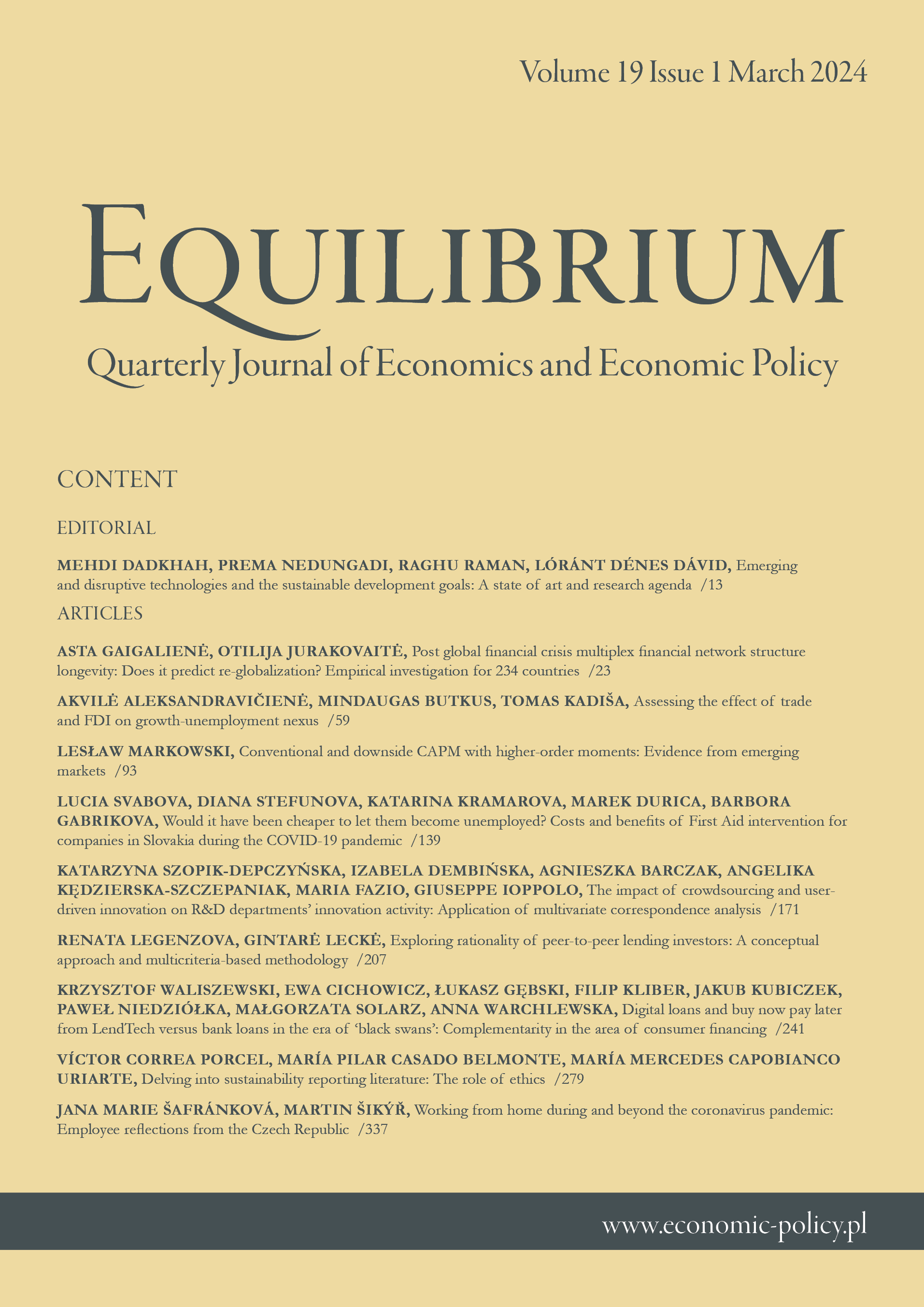描述和测试欧洲商业周期的不对称性
IF 5
Q1 ECONOMICS
Equilibrium-Quarterly Journal of Economics and Economic Policy
Pub Date : 2017-09-30
DOI:10.24136/EQ.V12I3.24
引用次数: 7
摘要
研究背景:商业周期的一个典型事实是,收缩比扩张更短,但持续时间更短,波动性更大,因此也不对称。研究经济周期不对称的存在和类型对经济政策分析和统计建模具有重要意义。商业周期不对称的经济含义是,经济紧缩时期的经济政策与经济扩张时期的经济政策应该不同。统计含义是,商业周期的线性模型无法捕捉到这种程式化的事实。文章目的:文章有两个目标:通过测试来自36个欧洲国家(包括以前从未分析过的国家)的数据来扩展关于商业周期不对称的文献,并测试结果对所使用的提取方法和不对称测试的稳健性。方法:使用欧盟统计局数据库中的季度GDP序列,涵盖2000年第一季度至2016年第一季度,有两个例外。就波斯尼亚-黑塞哥维那和黑山而言,采用了季度工业生产指数。采用X13-ARIMA程序去除季节成分制备系列。为了评估不对称测试结果对商业周期趋势替代方法的稳健性,我们使用两个滤波器:Corbae-Ouliaris理想带滤波器和双重Hodrick-Prescott滤波器提取结果。为了测试商业周期的深度和陡峭不对称性,使用了三个测试:Mills, Mira和Sichel测试。发现和增值:在塞浦路斯、黑山和土耳其周期中发现了较弱的深度不对称证据,其中两个过滤器的所有三个测试统计数据都为负值。然而,每个国家只有一项测试的结果具有统计学意义。对于另外两个国家,德国和瑞典,六次测试中有四次显示深度不对称,但其中只有一次测试结果具有统计学意义。除了爱尔兰的商业周期,以及波兰、马耳他、黑山和西班牙在一定程度上的周期外,大多数周期都表现出陡峭的不对称性。本文章由计算机程序翻译,如有差异,请以英文原文为准。
Characterising and testing European business cycles asymmetry
Research background: One of business cycles stylised facts is that contractions are shorter than expansions, but less persistent, more volatile, and therefore asymmetric. Investigating existence and type of business cycles asymmetry is important for analysis of economic policy and statistical modelling. Economic implication of business cycles asymmetry is that economic policy should be different in a period of contractions than in one of expansion. Statistical implication is that linear models of business cycles cannot capture this stylised fact. Purpose of the article: The article has two objectives: extend the literature on the business cycles asymmetry by testing data from 36 European countries including countries never been analysed before and test robustness of the results to extraction methods and asymmetry tests used. Methods: Quarterly GDP series from Eurostat database covering period 2000q1–2016q3 were used with two exceptions. In the case of Bosnia and Herzegovina and Montenegro quarterly industrial productions indexes were used. Series were prepared by removing seasonal component using X13-ARIMA procedure. To assess robustness of asymmetry tests results to alternative methods of detrending business cycles were extracted using two filters: Corbae-Ouliaris ideal band filter and double Hodrick-Prescott filter. For testing the deepness and steepness asymmetry of the business cycles three tests were used: Mills, Mira and Sichel tests. Findings & value added: Weaker evidence of deepness asymmetry was found in Cyprus, Montenegro and Turkey cycles, where all three tests statistics for both filters have a negative sign. However, only for one of the tests in each country the result was statistically significant. For two other countries, Germany and Sweden, four out of six tests indicated deepness asymmetry, but only one of these tests results was statistically significant. Most of the cycles show steepness asymmetry, with the exception of Ireland business cycles, and to a certain extent cycles of Poland, Malta, Montenegro and Spain.
求助全文
通过发布文献求助,成功后即可免费获取论文全文。
去求助
来源期刊
CiteScore
9.20
自引率
3.50%
发文量
28
审稿时长
36 weeks
期刊介绍:
Equilibrium. Quarterly Journal of Economics and Economic Policy is a scientific journal dedicated to economics, which is the result of close cooperation between the Instytut Badań Gospodarczych/Institute of Economic Research (Poland) and Polish Economic Society and leading European universities. The journal constitutes a platform for exchange of views of the scientific community, as well as reflects the current status and trends of world science and economy.
The journal especially welcome empirical articles making use of quantitative methods in: Macroeconomics and Monetary Economics, International Economics, Financial Economics and Banking, Public Economics, Business Economics, Labor and Demographic Economics, Economic Development, and Technological Change, and Growth.
Current most preferable topics and special issues:
The economics of artificial intelligence: business potentials and risks;
Digitalization and entrepreneurship in economics;
Sustainable socio-economic development, environmental and ecological economics;
Transition in the energy market (improving energy efficiency, alternative energy sources, renewable energy, energy security).

 求助内容:
求助内容: 应助结果提醒方式:
应助结果提醒方式:


